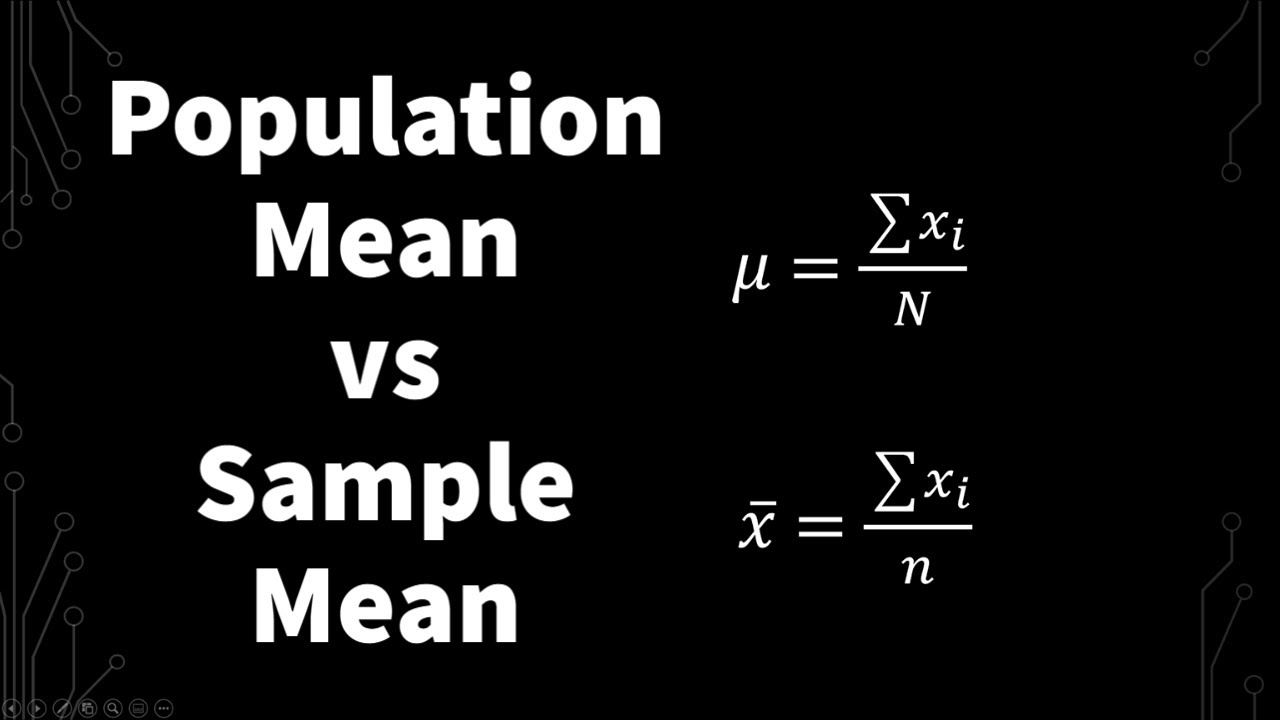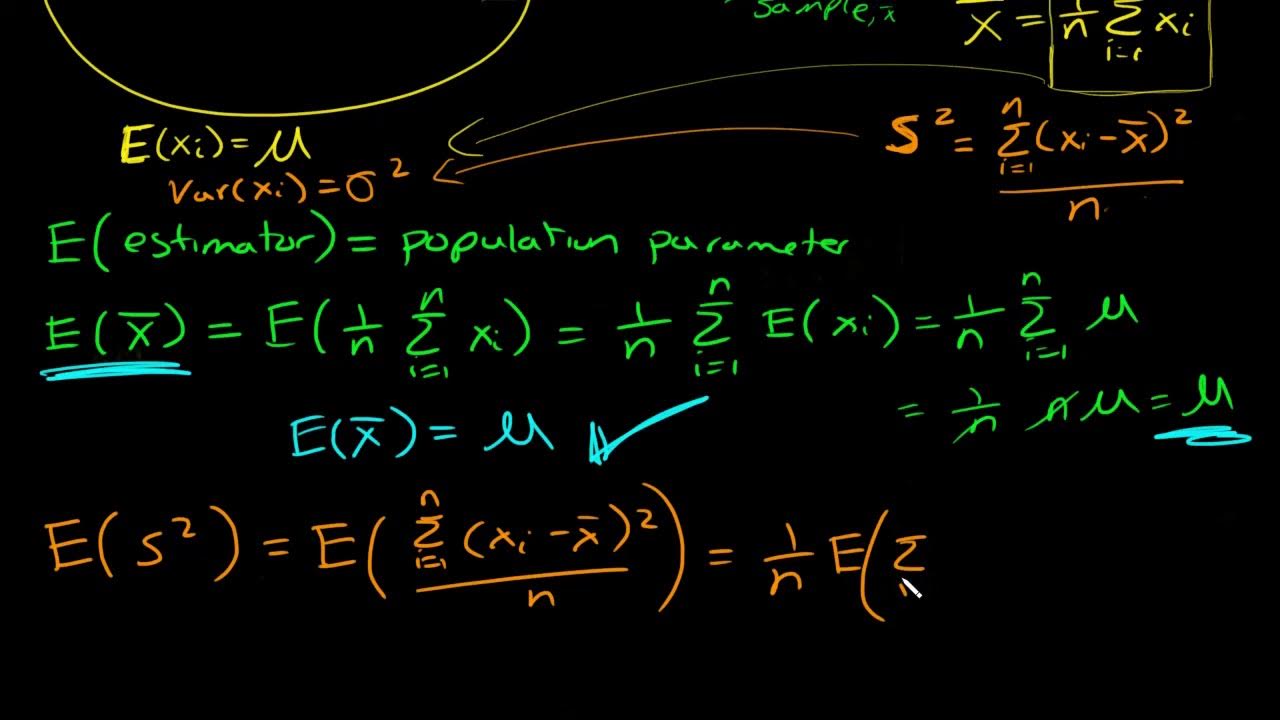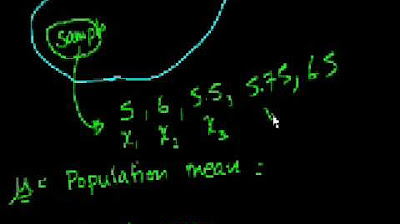How to Calculate Population Mean (Parameter and Examples) | Statistics
TLDRThe video script discusses the concept of population mean as a parameter, contrasting it with sample mean. It explains that a parameter is a constant, not an approximation, and provides two examples: calculating the average family size for seven families in a neighborhood and the average weight of all residents in a city with 2239 people. The script emphasizes the practicality of understanding population mean for real-world applications.
Takeaways
- 📝 The video discusses the concept of population mean and provides examples to illustrate it.
- 🔢 A parameter, such as the population mean (mu), is a constant that is not an approximation but an exact value.
- 🏠 The first example given is calculating the average family size of seven families in a neighborhood, which represents a population mean.
- 👨👩👧👦 To find the population mean, the sum of all values (x) is divided by the number of families (n), resulting in the average family size.
- 📊 The calculation yields a population mean of 3.43 for the given family size data.
- 🌆 The second example involves finding the average weight (in kilograms) of all 2239 people in a city, another instance of a population mean.
- 📈 The process for calculating the population mean weight involves summing up all individual weights and dividing by the total number of people.
- 🏋️ The average weight of the city's population is given as 76.3 kilograms, which is a true parameter, not an approximation.
- 🔍 The video emphasizes the difference between parameters and statistics, with parameters being true values for the entire population.
- 📊 The use of tools like Excel is suggested for handling large datasets to calculate population means efficiently.
- 💡 The video highlights the practical applications of understanding population means in real-world scenarios.
Q & A
What is the main topic of the video?
-The main topic of the video is to explain the concept of population mean and provide examples of how to calculate it.
What is the formula for calculating the population mean?
-The formula for calculating the population mean is the summation of x (i) over n, which equals mu (μ).
What is the difference between a parameter and a sample mean?
-A parameter is a fixed value that is true for the entire population, whereas a sample mean is an approximation of the population mean based on a subset of the data.
How do you calculate the population mean for the family sizes in a neighborhood with seven families?
-To calculate the population mean for the family sizes, you sum up all the family sizes (7, 1, 3, 2, 4, 3, and 4) and divide by the number of families (7), resulting in an average family size of 3.43.
What is the significance of knowing the population mean?
-Knowing the population mean is significant as it provides an exact value for the entire population, which can be useful for various real-world applications and decision-making processes.
How would you calculate the population mean weight of 2239 people in a city?
-To calculate the population mean weight, you would sum up the weights of all 2239 people and then divide by the total number of people (2239). In the video, this results in an average weight of 76.3 kilograms.
Why is it important to distinguish between a parameter and a statistic?
-It is important to distinguish between a parameter and a statistic because a parameter represents the entire population, while a statistic is an estimate based on a sample. Understanding this difference helps in accurately interpreting and applying statistical results.
What tool is commonly used to calculate the population mean for large datasets?
-For large datasets, tools like Excel or other statistical software are commonly used to calculate the population mean, as manual calculation would be impractical and time-consuming.
How does the concept of population mean relate to real-world applications?
-The concept of population mean relates to real-world applications by providing a way to understand and analyze the average characteristics of a population, which can inform decisions and policies in areas such as public health, urban planning, and social services.
What is the role of the population mean in statistical analysis?
-The population mean plays a crucial role in statistical analysis as it serves as a benchmark or standard for comparing data, calculating other statistics like standard deviation, and making inferences about the population from sample data.
Why might one want to calculate the population mean for different scenarios?
-One might want to calculate the population mean for different scenarios to gain insights into the central tendency of a population, which can help in understanding patterns, making predictions, and informing decisions in various fields such as business, research, and social sciences.
Outlines
📊 Understanding Population Mean
This paragraph introduces the concept of the population mean as a parameter that is an exact value, not an approximation. It contrasts this with the sample mean, emphasizing that the population mean represents the entirety of a dataset. The video aims to provide examples of calculating the population mean, using the formula mu = (Σxi) / n, where xi represents individual data points and n is the number of data points. The first example given is calculating the average family size for all seven families in a neighborhood. By summing the family sizes (7, 1, 3, 2, 4, 3, and 4) and dividing by 7, the result is an average family size of 3.43. This calculation demonstrates how the population mean can be determined for a small, complete dataset, which is applicable for understanding local demographics. The second example discusses calculating the average weight of all 2239 people in a city. While the individual weights are not listed, the process is the same: summing the weights and dividing by the total number of people. The result, 76.3 kilograms, is presented as the true average weight, not an estimate, highlighting the reliability of the population mean when the entire population is measured.
Mindmap
Keywords
💡Population Mean
💡Parameter
💡Sample Mean
💡Formula
💡Family Size
💡Weight
💡Excel
💡Statistic
💡Data Overload
💡Real World Application
💡Commentator Request
Highlights
The video discusses the concept of population mean and provides examples for better understanding.
A parameter, such as the population mean (mu), is an exact value, not an approximation.
The formula for population mean is the summation of x(i) over n, equal to mu.
The first example given is calculating the average family size of seven families in a neighborhood.
The population mean is calculated by summing all family sizes and dividing by the number of families.
The example demonstrates how to calculate the average family size as 3.43 people.
The video emphasizes the real-world application of calculating population mean for family sizes.
The second example is about finding the average weight of 2239 people in a city.
For large data sets like 2239 people's weights, software like Excel is used for calculations.
The average weight calculation results in a population mean of 76.3 kilograms.
The video clarifies that the population mean is a true value, not an approximation like a sample mean.
The video also touches on how parameters like population mean can be used to calculate standard deviation.
The content is engaging and educational, encouraging viewers to like, subscribe, and comment with questions.
The video is a response to a commenter's request, showcasing the video creator's interactive approach with the audience.
The video concludes with a call to action for viewers to stay engaged with the content and the community.
Transcripts
Browse More Related Video

Sample Mean and Population Mean - Statistics

Population Mean And Sample Mean (Explanation and Walkthrough Example) |Statistics

6.3.5 Sampling Distributions and Estimators - Biased and Unbiased Estimators

What is an unbiased estimator? Proof sample mean is unbiased and why we divide by n-1 for sample var

Statistics: Sample vs. Population Mean

6.4.4 The Central Limit Theorem - Finite Population Correction Factor
5.0 / 5 (0 votes)
Thanks for rating: